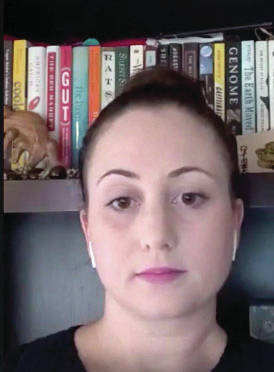More than 400 contact tracers are at work across Hawaii as the state continues to grapple with the COVID-19 pandemic.
Dr. Emily Roberson, the state Department of Health Disease Investigation Branch chief who is leading contact tracing efforts, said Wednesday during a livestream conversation with the Honolulu Star-Advertiser that there are 311 people directly working on case investigations and contact tracing on Oahu, and 417 working statewide.
The state has 20 teams with different special duties they are tasked with doing.
When asked if the team was big enough to handle the number of COVID-19 cases in Hawaii or a future spike, Roberson said the state has the capacity to handle “a whole lot more cases than we actually have.”
In terms of planning the staffing structure, she wanted to have enough staff to be able to comfortably handle 1,200 new cases a day.
“In reality, if we have 1,200 new cases of COVID every single day, contact tracing is the least of our concerns, and we’ve got bigger issues that are not necessarily going to be addressed by contact tracing.”
However, Roberson said the state is trying to recruit people for more specialized roles to fill in certain gaps.
Hawaii National Guard is still assisting in contact tracing efforts, but Roberson said decisions about what happens after federal coronavirus relief money expires at the end of the year are “above my pay grade.”
During the conversation, Roberson also explained the contact tracing process.
When someone tests positive for the coronavirus, Roberson said the case is typically reported to the state via an electronic lab report, which goes directly into a data tracking system.
Then a first contact call is made.
“From there, depending on their responses to the initial interview, then we can filter them in a variety of different ways, and we have specialized investigation teams that do followups in certain types of circumstances,” Roberson said. “So, for example, if we have a case that tests positive in a long-term care facility, we have a specialized response team of not only disease investigators, but also of infection prevention experts that can help the facility with infection prevention.”
According to Roberson, investigators are concerned about two time periods when considering exposure to the virus.
When investigating the likelihood that an individual has exposed others to COVID-19, Roberson said investigators typically examine the two days prior to the onset of symptoms or when the testing sample was collected, if the individual is asymptomatic.
“And that’s really out of concern for that individual being infectious to others,” Roberson said. “But then, when we’re trying to figure out where that individual contracted COVID-19, then that time period we’re asking about is typically 14 days.”
Roberson also noted that investigators don’t necessarily need specific details about every encounter during those time periods.
“We’re not seeing, necessarily, transmission happening in kind of incidental exposure settings, so really we’re asking about specific types of activities over those 14 days,” she explained. “So we don’t need to know every single place you went and every single person you saw, but we definitely need to know where you work, what your job is, when you were last at work, who you work closely with, and that sort of thing if you’re in certain types of professions.”
If, for example, a person works in a typical office setting and is in an office alone with minimal interaction with others, “that’s not a great concern to us.”
“However, if you work in a restaurant and the kitchen area is very small and it doesn’t have good ventilation and you’re regularly crammed in with 10 other coworkers, then that’s a situation where we’re going to ask you a whole lot more questions … because that’s of greater concern to us for disease transmission.”
When asked about how cases are spread and risky behaviors, Roberson said there have been concerns about activities like going to the grocery store or passing people on the street.
Those activities are fairly low risk, she said, and, “for me, personally, are not terribly concerning.”
But people let their guards down around family and friends.
Roberson said the state is seeing some clusters of COVID-19 associated with different types of workplace exposures, but a majority of cases come from household transmissions and small gatherings with friends and family.
“It’s still primarily community-driven outbreak, not so much associated with travel as of right now,” she said.






